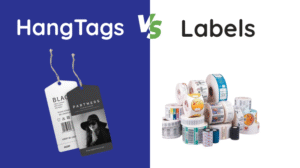Across the retail and design industries, the use ofhang tagshas been established as an integral part of product presentation. Their presence can be observed in clothing collections, boutique packaging, and artisan merchandise, where brand information, care details, and pricing are communicated through compact visual design.
Usually made from cardboard, kraft paper, or recycled material, a swing tag carries more than just a logo. One side may show the brand name or emblem, while the other often includes important details like price, size, and care instructions. Though it is small, it creates a meaningful first impression that connects the product to the story behind it.
In this blog, you will get to know what a hang tag is, what details they include, and why they remain an important element of product branding and consumer perception.
Key Takeaways
- A hang tag is a small printed label attached to a product with a string, ribbon, or loop that communicates essential details like size, price, material, care instructions, and brand identity.
- Hang tags help convey your brand’s personality, values, and craftsmanship, creating an emotional connection with customers and enhancing perceived value.
- They provide product info for compliance and customer clarity while enabling engagement through QR codes, social handles, and promotional messages.
What is a hang tag?
A hang tag, also called a swing tag, clothing tag, or price tag, is a small printed label that is attached to a product using a cotton thread, ribbon, or plastic loop. It is most often seen on garments, fashion accessories, handcrafted goods, and boutique merchandise, where it helps present essential details before a purchase is made.
Unlike a sewn-in label, a hang tag is temporary and designed to be removed after purchase. Its main purpose is to communicate practical information—such as product size, price, fabric composition, and care instructions—while also introducing the brand’s visual identity through design, color, and texture.
Core functions of a hang tag
- Product identification:The tag names the product or model. It carries SKU and barcode data for inventory flow.
- Pricing and point of sale information:The tag gives the price and discount details in retail settings. It can include seasonal codes for promotions.
- Care and composition guidance:Fabric content, washing instructions and country of origin are placed on the tag to inform use and to satisfy compliance in many markets.
- Brand and story communication:Short brand narratives, craft notes, designer signatures and mission statements are often printed on hang tags.
- Marketing and conversion triggers:QR codes, social handles, and short CTAs are used to drive online traffic, product registration, and user-generated content.
- Authentication and provenance:For premium goods, serial numbers, holograms, and tamper tags are used to prove authenticity.
- Legal and regulatory notices:Where required, care symbols, fiber percentages, and country labels are included to comply with local law.
Information to include on hang tags
A hang tag should balanceproduct details and brand communication. The following elements make it both informative and visually effective:
- Brand identity:Add your brand name, logo, and tagline to reinforce recognition and consistency.
- Product details:Clearly mention the size, color, and material composition (e.g., 100% cotton).
- Price:Display the price clearly so customers can make quick purchase decisions.
- Country of origin:Indicate where the product was made, as this is often a compliance requirement.
- Manufacturer information:Include your brand name or a registered identification number (RN#) if applicable.
- Care instructions:Provide simple guidelines for washing, ironing, or maintaining the product’s quality.
- Marketing elements:Add social media handles, website links, or QR codes to encourage engagement.
- Brand story:Share a brief note about your brand’s values or craftsmanship to build an emotional connection.
What are the different types and styles of hang tags?
Hang tags come in various forms, each serving a unique role in retail presentation and communication.
- Brand Tag:Highlights the logo and brand story to strengthen identity. Common in boutique and designer collections.
- Price Tag:Displays price, SKU, and barcode for easy scanning and quick reference in retail settings.
- Care Tag:Lists washing, drying, and handling instructions for garments, linens, and textile items.
- Promotional Tag:Used for special offers, discounts, or limited-edition releases to draw customer attention.
- Security Tag:Incorporates holograms, tamper-proof features, or serial codes to prevent counterfeiting.
- Multi-Panel Tag:Combines multiple panels to separate product information from branding or marketing text.
- Loop Tag:Loop tags are soft and flexible, tied with a string or cord, while swing tags are stiffer and often used for polished, high-end displays.
What materials are used to make hang tags and why do they matter?
The material used in hang tags affects their durability, texture, and the way a brand is perceived. The right choice aligns design with product identity.
- Uncoated Paper and Kraft Paper:Provide a natural, textured look ideal for organic and handmade products.
- Coated Cardstock:Smooth and glossy surface suited for sharp, full-color printing in lifestyle brands.
- Recycled Fiber Stock:Eco-friendly option that reflects sustainability values and green practices.
- Synthetic Paper and Plastic:Resistant to water and wear, perfect for outdoor gear and swimwear.
- Cotton or Linen Stock:Adds a fabric-like texture that complements clothing and textile products.
- Leather and Faux Leather:Brings luxury appeal and durability to accessories and footwear.
- Metal or Acrylic:Used in premium or collectible items where the tag doubles as a design element.
How to design an effective hang tag?
A well-designed hang tag should combine visual appeal with clarity. Focus on:
- Layout:Arrange logo, product details, and price in a clear hierarchy.
- Typography:Choose readable fonts that reflect your brand style.
- Color and Finish:Match colors with your packaging or logo for consistency.
- Material Feel:Select textures that align with your product—smooth for modern brands, kraft for natural ones.
- Interactive Elements:Add QR codes, embossed logos, or matte and gloss finishes to enhance engagement.
Why are hang tags important for brand perception?
Now that you know your banner options, it is important to figure out what works best for your setup. Choosing the right size affects readability, design, and the overall impact of your banner.
Hang tags shape how customers perceive your brand before they even use the product. They:
- Create a first impressionthat reflects product quality and craftsmanship.
- Tell your brand story, helping customers connect emotionally.
- Increase perceived value, especially with premium materials and finishes.
- Build brand recall, as many customers keep or notice unique tags after purchase.
Conclusion
Small details make a big difference in retail and design. Hang tags are more than decorative pieces—they showcase your brand, provide essential product information, and add a touch of storytelling that connects with customers. Choosing the right material, style, and design elevates your product’s presentation, enhances perceived value, and leaves a lasting impression.
Stand out with custom printed hang tags from Print to Brand that work as hard as your brand does—turn every product into a statement.




